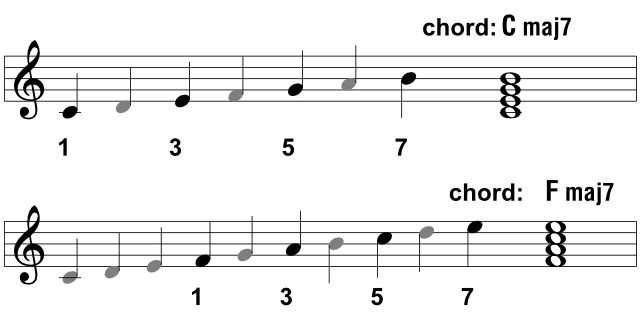Beyond Triads
Following on from part 1 here
We will call these “special chords” as they don’t quite fit into the 1 3 5 7 method of chord construction we have learned so far, but really they aren’t that special so don’t be scared of them. Up until now we have been constructing chords by counting up the scale from the root of the chord, and leaving out every other note. So the chord consists of the 1st, 3rd and 5th scale degrees (if it is a triad), or the 1st, 3rd, 5th and 7th if it is a four-note chord.
These chords are quite common in many styles, so it is worth learning how they are made up and when they can be used.
The major 6 chord.
This is a chord that we can use instead of a major 7. We learned earlier that (in a major key) we can use a major 7 chord as chord I or chord IV.
So just to recap, in the key of C major this is the C Major 7:

However if we use the 6th degree of the scale instead of the 7th note, we get this:

Why the major 6 chord?
There are a couple of reasons:
- It is possible that the melody (whether an instrument or a singer) may be the same as the root of the chord. If it is higher than the major 7 of the chord, then this means there is a semitone between the melody and the chord note. The dissonance may not sound good, even though it is chord note. It is usually fine if it is a short note, however if it is sustained then it will probably not sound so good (and make it it difficult for a singer to pitch. In this case a majr 6 is a good alternative if you want a four-note chord.
- It has a different sound to a major 7, and in the context you might prefer it.
Can you have a minor 6 chord?
Yes, the same process applies in a minor key, however it is a bit more complex in some cases so we will look at those in a more advanced course.
Can you have a 6 chord instead of a dominant 7?
Theoretically you could, but it would lose the value it has as a dominant chord. For further explanation, please refer back to part 1 (the book) chapters 3 and 4.
Sus Chords
In part 1 we mentioned suspensions as non-chord notes that are placed on a strong beat, not merely passing notes. As we know the basic chord notes of a triad are the 1, 3 and 5 and that we also can have a 7 in a four-note chord, then the notes we can use melodically as suspensions are the other notes, ie the 2, 4 and 6.
We also mentioned that of all these, the suspended 4th is the most dissonant, as it is just one semitone above the 3rd. This means that if you play a 4th as a suspension, then if you sustain it for very long it can sound too dissonant for some styles. However, it is possible for the suspension to be part of the chord, and in this case we would have the 4th actually as part of the chord instead of the 3rd.

The sus 4 chord is often just referred to as a sus chord.
Can a minor be a sus chord?
Yes, a minor chord can easily be a sus chord. Again, in the key of C here is a sus 4 chord built on chord IIm:

Can a dominant 7 be a sus chord?
Yes. Here you can see how to construct a sus chord using the dominant (V7)

This does not have the same tension as a normal dominant-type chord because there is no tritone. However it still has tension due to the suspension. Also, it will often resolve to a G7.